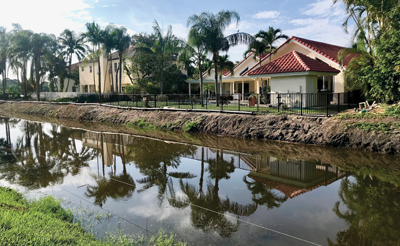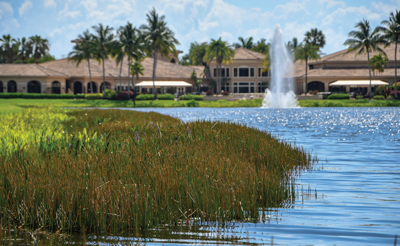
Is Your Lake Shoreline Putting Your Property Value and Residents at Risk?
By SOLitude Lake Management / Published April 2023

Imagine driving down a new street and noticing the most beautiful house you’ve ever seen. Its bright paint, glistening windows, and clean, welcoming porch show that it’s well cared for. But you find yourself distracted by something—a neglected lawn. It’s overrun with weeds, debris, and uprooted trees. It has dusty bare spots and deep channels where water flows anytime it rains. How can the owners take pride in their home when the yard looks like this?
There is a similar problem aquatic experts see with lakes and ponds. No matter how much a community association prioritizes water quality, it will never reach its full potential without a healthy shoreline. Just as a neglected lawn can lead to complaints from neighbors, cause home values to plummet, and even rack up citations by the city, so can a deteriorated shoreline.
Most shoreline damage doesn’t occur overnight. It slowly develops over the course of several years. If you assumed responsibility of a waterbody when it was in good condition, it can be easy to overlook the signs of deterioration—and forget that it’s much more than an aesthetic problem. Shorelines with deep grooves, cracks, exposed pipes, and steep, jagged peninsulas can lead to constant gripes from homeowners and cause serious safety issues for residents, guests, employees, landscapers, and other vendors working around the property. If someone falls or is injured as a result of a neglected shoreline, the association could be held liable.
Waterbodies with degraded shorelines also tend to experience flooding problems. Most of the ponds we see in HOAs, POAs, CDDs, and urban areas are man-made to collect stormwater when it rains. Eroded sediment can fill them with muck, reducing depth and volume. Dangerous flooding is more likely to occur if the stormwater facility cannot function properly. In addition to the liabilities this can cause, flooding expedites the rate of erosion and may cause waterfront properties—and their estimated value—to “shrink” over time.
In addition to the obvious signs of erosion, property managers may notice that maintaining healthy water quality is becoming more challenging. Lakes and ponds filled with muck are more likely to have dissolved oxygen (DO) deficiencies and elevated nutrient levels. These imbalances often manifest as nuisance aquatic weed and toxic algae blooms, fish kills, bad odors, and cloudiness–resulting in an unsightly lake and an influx of complaints from residents.
These problems aren’t just at the surface level, and they can have disastrous, lasting consequences for residential communities. According to a 35-year study of 2,000 lake homes, Bemidji State University in Minnesota found that a three-foot decrease in lake clarity caused a $700 decrease in the sale price per foot of shoreline. For example, this calculates to a $28,000 decline in the value of a 40-ft. waterfront lot. We know the effects of erosion can be stressful, but when you fully understand how it occurs, you can implement strategies that will help preserve property values and make your job easier over time.
Poor shoreline management can also accelerate the timeline for more substantial maintenance services like dredging, which is one of the largest expenses a community may ever face. Though all waterbodies will need to be reset at some point by digging out all accumulated sediment, communities usually have 20–30 years to plan and budget for a major dredging project. In cases of severe erosion, this could drop to less than 10 years, leaving community leaders in a very difficult position—divert funds from other important maintenance projects or increase dues and suffer the blowback?
Once erosion occurs, it can be difficult to halt future damage. When partnering with a professional, choose one who will work with you to evaluate the level of deterioration and muck development and design a restoration plan that’s customized to the unique qualities of your waterbody. Often, these involve the use of tools that allow aquatic experts to bioengineer a new shoreline that is incredibly stable and aesthetically pleasing. The professional may recommend pairing these efforts with mechanical hydro-raking to scoop out bottom muck in target areas, which will then be shaped and sodded over to re-establish several feet of land back to the property.
Shoreline erosion is a slow burn; it’s easy to ignore, but it’s also easy to intervene to halt. Professionals recommend integrating several of the following proactive solutions into the ongoing maintenance practices on your property:
- Cultivate a beneficial buffer of tall native plants around the perimeter of your waterbody to slow stormwater runoff and help hold the soil in place.
- Monitor wildlife populations—species like musk-rats and invasive armored catfish (found primarily in Florida) are known to bur-row and destabilize banks.
- Introduce docks or special paths for visitors to safely fish, kayak, or enjoy the view without trampling vulnerable areas.
- Partner with a professional to regularly survey the area for invasive weeds that can quickly take over sensitive shorelines.
- Properly dispose of yard waste, pet droppings, trash, and other debris so it doesn’t decay and contribute to muck build up in your waterbody.
- Reduce the use of lawn and garden fertilizers, which fuel the growth of aquatic weeds and algae.
- Break down muck by introducing nutrient remediation products, biologically beneficial bacteria, and aerators that increase DO, which is essential to the digestion process.
While erosion is a natural part of pond ownership, property managers have a lot of control over how quickly it occurs. Responsible management practices not only help enhance aesthetics and recreational opportunities but also safeguard the value and reputation of a community.
Become the most desirable community in your region with beautiful, healthy lakes and ponds. With proactive shoreline solutions in place, you can be at ease knowing your water, residents, and assets are protected from future erosion damage.
SOLitude Lake Management
SOLitude Lake Management is a leading environmental firm specializing in the sustainable management of lakes, stormwater ponds, wetlands, and fisheries. Learn more about this topic at www.solitudelakemanagement.com/knowledge.






